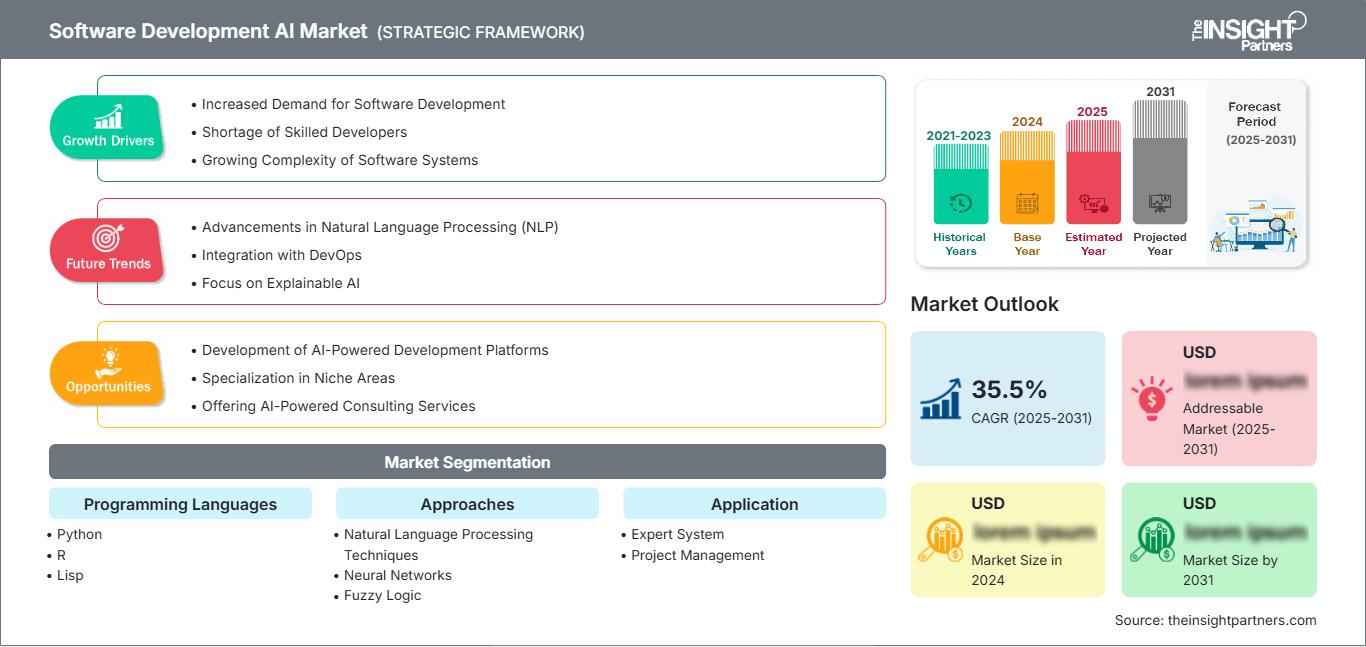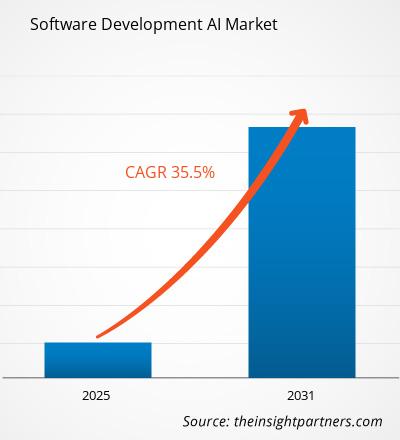Der Markt für KI-Softwareentwicklung wird voraussichtlich zwischen 2025 und 2031 eine durchschnittliche jährliche Wachstumsrate (CAGR) von 35,5 % verzeichnen, wobei die Marktgröße von XX Millionen US-Dollar im Jahr 2024 auf XX Millionen US-Dollar im Jahr 2031 anwachsen wird.
Der Bericht ist segmentiert nach Programmiersprachen (Python, R, Lisp, Prolog, Java, andere); Ansätzen (Techniken der natürlichen Sprachverarbeitung, neuronale Netzwerke, Fuzzy-Logik, Ant Colony Optimization (ACO), Data Mining, andere); Anwendung (Expertensystem, Projektmanagement, andere). Die globale Analyse ist weiter auf regionaler Ebene und nach den wichtigsten Ländern aufgeschlüsselt. Die globale Analyse ist auf regionaler Ebene und nach den wichtigsten Ländern aufgeschlüsselt. Die Marktbewertung wird für die obige segmentierte Analyse in US-Dollar angegeben.
Zweck des Berichts
Der Bericht „Markt für KI-Softwareentwicklung“ von The Insight Partners soll die aktuelle Situation und das zukünftige Wachstum sowie die wichtigsten treibenden Faktoren, Herausforderungen und Chancen beschreiben. Dadurch erhalten verschiedene Geschäftsinteressenten Einblicke, beispielsweise:
- Technologieanbieter/-hersteller: Um die sich entwickelnde Marktdynamik zu verstehen und die potenziellen Wachstumschancen zu kennen, sodass sie fundierte strategische Entscheidungen treffen können.
- Investoren: Um eine umfassende Trendanalyse hinsichtlich der Marktwachstumsrate, der finanziellen Marktprognosen und der Chancen entlang der Wertschöpfungskette durchzuführen.
- Regulierungsbehörden: Um Richtlinien und Überwachungsaktivitäten auf dem Markt zu regulieren, mit dem Ziel, Missbrauch zu minimieren, das Vertrauen der Investoren zu wahren und die Integrität und Stabilität des Marktes aufrechtzuerhalten.
Softwareentwicklung KI Marktsegmentierung Programmiersprachen
- Python
- R
- Lisp
- Prolog
- Java
Ansätze
- Techniken der natürlichen Sprachverarbeitung
- Neuronale Netze
- Fuzzy-Logik
- Ameisenkolonie-Optimierung
- Data Mining
Anwendung
- Expertensystem
- Projektmanagement
Geographie
- Nordamerika
- Europa
- Asien-Pazifik
- Süd- und Mittelamerika
- Naher Osten und Afrika
Sie erhalten kostenlos Anpassungen an jedem Bericht, einschließlich Teilen dieses Berichts oder einer Analyse auf Länderebene, eines Excel-Datenpakets sowie tolle Angebote und Rabatte für Start-ups und Universitäten.
Markt für Softwareentwicklung und KI: Strategische Einblicke

- Holen Sie sich die wichtigsten Markttrends aus diesem Bericht.Dieses KOSTENLOSE Beispiel umfasst Datenanalysen, die von Markttrends bis hin zu Schätzungen und Prognosen reichen.
Wachstumstreiber für den KI-Markt für Softwareentwicklung
- Steigende Nachfrage nach Softwareentwicklung: Das schnelle Wachstum digitaler Technologien und die zunehmende Abhängigkeit von Software in verschiedenen Branchen treiben die Nachfrage nach schnellerer und effizienterer Softwareentwicklung voran.
- Mangel an qualifizierten Entwicklern: Ein weltweiter Mangel an qualifizierten Softwareentwicklern schafft einen Bedarf an Tools, die die Produktivität der Entwickler steigern und die Qualifikationslücke schließen können.
- Zunehmende Komplexität von Softwaresystemen: Moderne Softwaresysteme werden immer komplexer und erfordern ausgefeilte Tools zur Verwaltung von Entwicklung, Tests und Bereitstellung.
Zukünftige Trends im KI-Markt für Softwareentwicklung
- Fortschritte in der Verarbeitung natürlicher Sprache (NLP): NLP wird Entwicklern die Interaktion mit KI-Tools in natürlicher Sprache ermöglichen, was intuitivere und effizientere Entwicklungsprozesse ermöglicht.
- Integration mit DevOps: KI-gestützte Tools werden sich nahtlos in DevOps-Workflows integrieren und Aufgaben wie kontinuierliche Integration, kontinuierliche Bereitstellung und Infrastrukturbereitstellung automatisieren.
- Fokus auf erklärbare KI: Die Nachfrage nach KI-Modellen, die ihre Funktionsweise erklären können, wird steigen. Dadurch wird es für Entwickler einfacher, die Entscheidungen von KI-gestützten Entwicklungstools zu verstehen und ihnen zu vertrauen.
Marktchancen für KI in der Softwareentwicklung
- Entwicklung von KI-gestützten Entwicklungsplattformen: Schaffung umfassender Plattformen, die verschiedene KI-gestützte Tools für den gesamten Softwareentwicklungszyklus integrieren.
- Spezialisierung auf Nischenbereiche: Konzentration auf KI-gestützte Lösungen für bestimmte Domänen, wie KI für die Spieleentwicklung, KI für eingebettete Systeme oder KI für die Entwicklung mobiler Apps.
- Angebot von KI-gestützten Beratungsdiensten: Bereitstellung von fachkundigen Beratungsdiensten, um Unternehmen dabei zu helfen, KI zu nutzen, um ihre Softwareentwicklungsprozesse zu verbessern und bessere Ergebnisse zu erzielen.
Markt für KI-Softwareentwicklung
Die Analysten von The Insight Partners haben die regionalen Trends und Faktoren, die den Markt für KI-Softwareentwicklung im Prognosezeitraum beeinflussen, ausführlich erläutert. In diesem Abschnitt werden auch die Marktsegmente und die geografische Lage in Nordamerika, Europa, dem asiatisch-pazifischen Raum, dem Nahen Osten und Afrika sowie Süd- und Mittelamerika erörtert.Umfang des Marktberichts zur Softwareentwicklung mit KI
| Berichtsattribut | Einzelheiten |
|---|---|
| Marktgröße in 2024 | US$ XX million |
| Marktgröße nach 2031 | US$ XX Million |
| Globale CAGR (2025 - 2031) | 35.5% |
| Historische Daten | 2021-2023 |
| Prognosezeitraum | 2025-2031 |
| Abgedeckte Segmente |
By Programmiersprachen
|
| Abgedeckte Regionen und Länder | Nordamerika
|
| Marktführer und wichtige Unternehmensprofile |
|
Dichte der Marktteilnehmer im Bereich KI für Softwareentwicklung: Auswirkungen auf die Geschäftsdynamik verstehen
Der Markt für KI-Softwareentwicklung wächst rasant. Dies wird durch die steigende Nachfrage der Endnutzer aufgrund veränderter Verbraucherpräferenzen, technologischer Fortschritte und eines stärkeren Bewusstseins für die Produktvorteile vorangetrieben. Mit der steigenden Nachfrage erweitern Unternehmen ihr Angebot, entwickeln Innovationen, um den Bedürfnissen der Verbraucher gerecht zu werden, und nutzen neue Trends, was das Marktwachstum weiter ankurbelt.

- Holen Sie sich die Markt für Softwareentwicklung und KI Übersicht der wichtigsten Akteure
Wichtige Verkaufsargumente
- Umfassende Abdeckung: Der Bericht analysiert umfassend Produkte, Dienstleistungen, Typen und Endnutzer des Marktes für Softwareentwicklungs-KI und bietet einen ganzheitlichen Überblick.
- Expertenanalyse: Der Bericht basiert auf dem umfassenden Verständnis von Branchenexperten und Analysten.
- Aktuelle Informationen: Der Bericht gewährleistet Geschäftsrelevanz durch die Berichterstattung über aktuelle Informationen und Datentrends.
- Anpassungsoptionen: Dieser Bericht kann an spezifische Kundenanforderungen angepasst werden und passt sich optimal an die Geschäftsstrategien an.
Der Forschungsbericht zum Markt für Softwareentwicklungs-KI kann daher dazu beitragen, die Branchensituation und die Wachstumsaussichten zu entschlüsseln und zu verstehen. Obwohl es einige berechtigte Bedenken geben kann, überwiegen die Vorteile dieses Berichts tendenziell die Nachteile.
- Historische Analyse (2 Jahre), Basisjahr, Prognose (7 Jahre) mit CAGR
- PEST- und SWOT-Analyse
- Marktgröße Wert/Volumen – Global, Regional, Land
- Branchen- und Wettbewerbslandschaft
- Excel-Datensatz
Aktuelle Berichte
Verwandte Berichte
Erfahrungsberichte
Grund zum Kauf
- Fundierte Entscheidungsfindung
- Marktdynamik verstehen
- Wettbewerbsanalyse
- Kundeneinblicke
- Marktprognosen
- Risikominimierung
- Strategische Planung
- Investitionsbegründung
- Identifizierung neuer Märkte
- Verbesserung von Marketingstrategien
- Steigerung der Betriebseffizienz
- Anpassung an regulatorische Trends




















 Kostenlose Probe anfordern für - Markt für Softwareentwicklung und KI
Kostenlose Probe anfordern für - Markt für Softwareentwicklung und KI